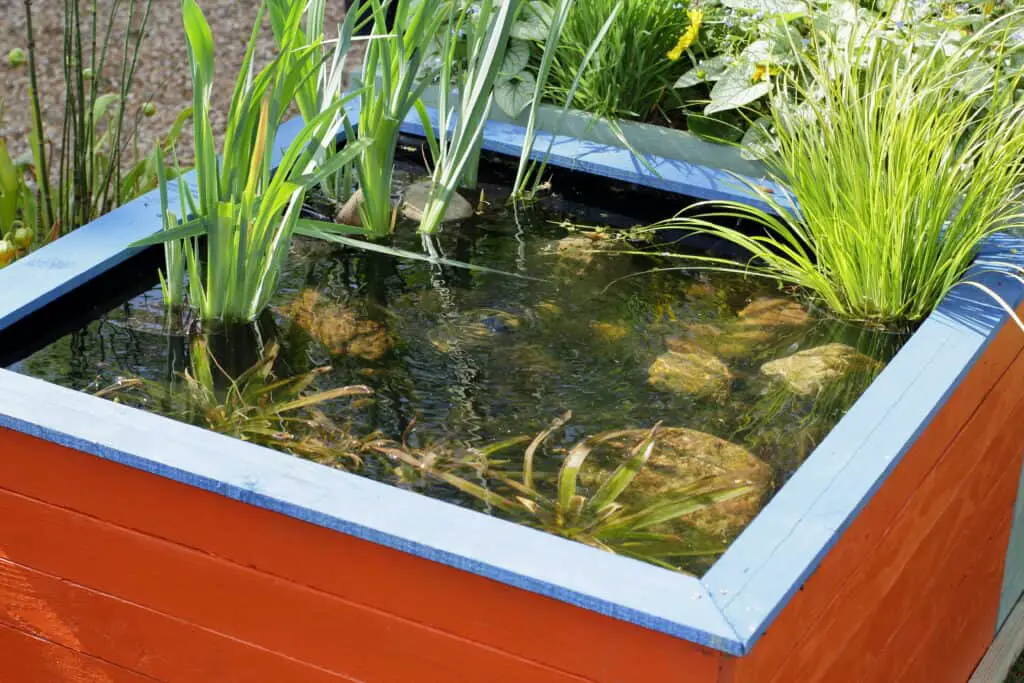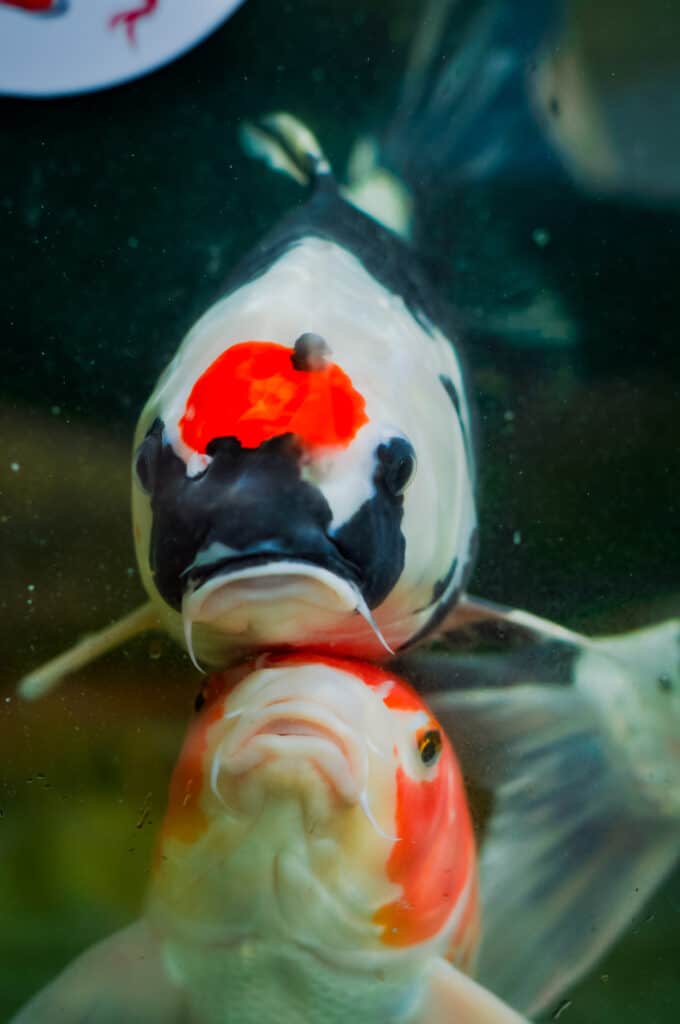
Koi fish are the epitome of ponds that add tranquility to a garden. They are mesmerizing and can be tamed to eat from your hand. One of the benefits of an above-ground Koi pond is sitting on the edge and feeding your koi without kneeling uncomfortably on the ground.
Making a koi pond above ground is more accessible than a regular pond as you do not need to dig. As with a below-ground pond, you will need a solid foundation, a good water filter, a water pump, and some way of aerating the water, such as a waterfall.
Planning is a key aspect of successfully making an above-ground koi pond, but once the planning is done, the fun of building the pond can begin. Follow our detailed guide to building your above-ground koi pond to avoid making costly mistakes and installing unnecessary equipment or features.
Pro Tip: If you’re tired of wasting money and making costly mistakes on the koi-keeping hobby or are thinking about buying koi fish but don’t know where to start, I strongly suggest you check out this ebook. I recently read this ebook, and it contains SO much useful information, such as:
- 3 proven steps to identify koi fish diseases
- WARNING: 3 things you should NEVER do when it comes to caring for koi
- When to seek professional help when it comes to looking after your koi
How To Build A Koi Pond Above The Ground

No architect builds a house without a plan, and making a pond is no different. The rest of the steps will be so much easier with proper planning.
Before you start making your pond, you need to decide on the location and size of your pond. Preferably, your pond should be partly in the shade. Koi need a few hours of sun to provide them with adequate vitamin D, but the shade will keep algae from blooming and affecting the pH level of the water.
Laying out your pond on the ground will help you visualize the end result of your pond and make any changes before you start the building process. A rope works excellent to outline the border of your pond.
The easier way of making a koi pond by yourself is to use good-quality timber and pond liner. Concrete ponds require more tools and skills and are best suited for those with building experience.
Step One: Prepare The Foundation Of Your Koi Pond
Once you are happy with the final layout, it is time to prepare your foundation. A good foundation will ensure that your pond lasts for years to come.
Your foundation needs to be level. If the location of your pond is on a slope, you will need to dig into the slope slightly. As the pond will be above the ground, you only need to dig to ensure the bottom is flat and remove any rocks or roots that can damage your pond liner.
Use a level to measure the flatness of your foundation. Placing a straight board or timber piece on the ground will give you the most accurate reading. Add or remove more ground until the area is level.
Cover it with a plastic liner and add leveling sand onto the plastic when the ground is level. The plastic liner prevents the leveling sand from sinking into the ground below, creating a hurdle for weeds and roots from surrounding plants.
Step Two: Build The Wall Of Your Pond
With your foundation level, you can start building up the wall of your pond. Cut your timber to the dimensions you need. Some hardware stores will cut timbers according to your measurements.
Lay down the first layer of timber and secure them with timber nails. Keep laying the timbers down and securing each layer of timber to each other and the layer below. Measure the level with each layer of time to ensure the wall remains even. Continue until you reach your desired height.
Step Three: How To Line Your Koi Pond With A Pond Liner
A good quality pond liner is the easiest way to waterproof the wall of your pond. Pond liners come in different thicknesses and quality. It is worth spending a bit more to buy a thick, high-quality liner that will not tear or leak.
As the surface of the timbers is course and can damage your liner, it is advisable to place a geotextile pond-liner underlay sheet between the timbers and the pond liner. The underlay sheet is a barrier and protects your pond liner from abrasions.
Place the pond liner inside the pond, leaving a few feet over the edges of the walls. At this point, you want to fill the pond with water. This is essential as the water will way down the pond liner and secure it to the interior walls. Use your hands to even out the liner as the water fills. Secure the liner to the top layer of timber.
Step Four: Install A Pump And Water Filter Into Your Pond
Pond kits are readily available and include a water filter and pump. The installation will depend on the model; most filters and kits will have instruction manuals.
The function of a filter is to clean the water of debris, algae, and fish excrement. Clean water means happy and healthy koi. Filters also clear the water and allow you to see your beautiful koi.
Thus, you should choose the best quality filter you can afford. The filter you choose must be big enough for the size of your pond.
While you do not need a waterfall, it is highly recommended. The sound of water adds to the tranquility of the pond and, more importantly, adds oxygen to the water.
Installing an air pump is another way of adding oxygen to the water. Air pumps can be a great option if you live in a colder climate.
Step Five: Add Your Koi Fish To The Pond

Now that your pond is complete, it is time to add the fish. Adding your koi to your pond is by far the most exciting part!
It is very important to ensure that the water is safe for your koi. Let the pump run for a few days up to a week to allow the debris from the building process to clear. Measure the temperature and pH level of the water before adding your koi.
Koi, like all fish, need to acclimatize to new water. Allow them to sit in a plastic bag inside the pond for a few hours to avoid shock from sudden temperature changes. Add them one by one to the pond.
What Is The Best Size For A Koi Pond?
The size of your koi pond will depend on the amount of koi fish you wish to have and, of course, your available space. Contrary to popular belief, they can outgrow their pond, so go as big as your space permits.
Koi fish can grow up to 30 inches, sometimes more, and need lots of space. A pond of 2000 gallons will be big enough for about eight mature koi fish. Mature koi are happiest with 250 gallons of water each.
A good size for a pond is about 2500 gallons, with a depth of 4.5 feet. A pond this size will allow ten koi fish to mature to their full size. At the very least, your pond should be no less than 3 feet deep and hold 1000 gallons of water.
Conclusion
Building a koi pond above the ground is relatively easy and won’t cost a fortune with proper planning. While making a pond may take a few weeks, you will enjoy the benefits of your hard work for years to come. Well worth the effort!
References
https://www.sun-sentinel.com/entertainment/wsfl-koi-pond-create-htmlstory.html
https://www.hartz.com/things-to-consider-before-starting-a-koi-fish-pond/ https://www.reddit.com/r/ponds/comments/k9bgz1/considering_building_a_koi_pond_what_tips_and/
https://www.instructables.com/The-Ultimate-Koi-Pond/ https://www.youtube.com/watch?v=wGrf2vivlpM

